Moderate overlap front: original test
Rating applies to 2005-12 models
Tested vehicle: 2008 Nissan Frontier SE Crew Cab
The Nissan Frontier Crew Cab and King Cab were redesigned for the 2005 model year and are significantly larger and heavier than previous models. The Suzuki Equator Crew Cab and Extended Cab were introduced in the 2009 model year. Two tests of the Frontier were conducted, one by the Institute of a 2wd King Cab and the other by Nissan of a 2wd Crew Cab. The overall rating of Good is based on review of both tests, which independently result in overall ratings of Good. The ratings and vehicle specifications based on Nissan's test are shown below because the 2wd Crew Cab is similar to the configuration of other pickups tested more recently.
| Evaluation criteria | Rating |
|---|---|
| Overall evaluation | |
| Structure and safety cage | |
| Driver injury measures | |
| Head/neck | |
| Chest | |
| Leg/foot, left | |
| Leg/foot, right | |
| Driver restraints and dummy kinematics | |

Action shot taken during the Institute's frontal offset crash test.
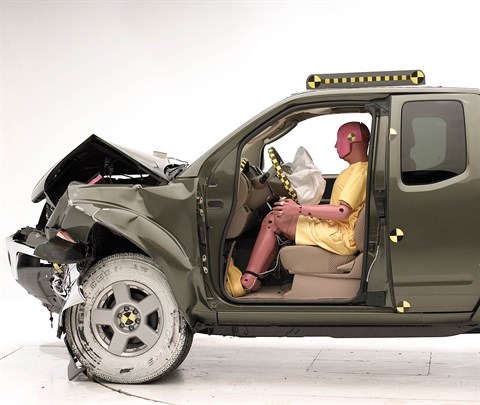
The dummy's position in relation to the steering wheel and instrument panel after the crash test indicates that the driver's survival space was maintained well (Institute test vehicle shown).
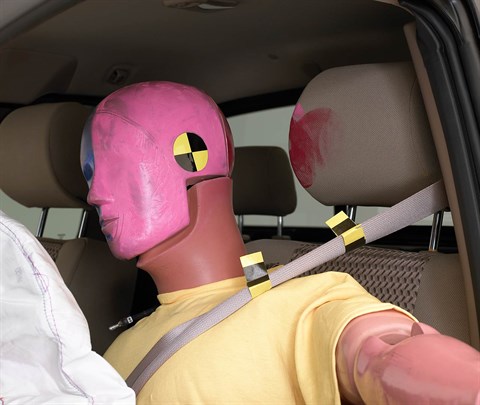
Dummy movement was well controlled in both tests. During rebound, the dummy's head hit only the head restraint.
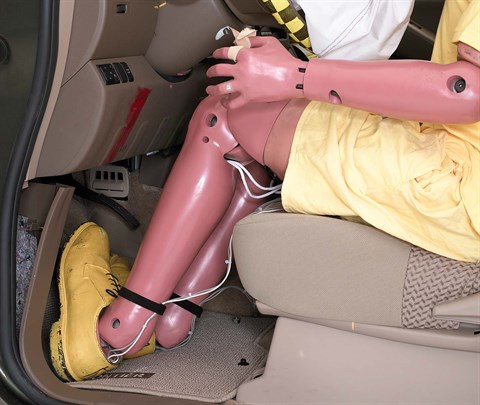
In both tests, forces on the left knee and the right lower leg were high enough to indicate the possibility of injuries (Institute test shown).
Measures of occupant compartment intrusion on driver side
| Evaluation criteria | Measurement | |
|---|---|---|
| Test ID | CEF0504 | VTF0812 |
| Footwell intrusion | ||
| Footrest (cm) | 11 | 12 |
| Left (cm) | 12 | 13 |
| Center (cm) | 14 | 15 |
| Right (cm) | 12 | 13 |
| Brake pedal (cm) | 7 | 6 |
| Instrument panel rearward movement | ||
| Left (cm) | 1 | 0 |
| Right (cm) | 1 | -1 |
| Steering column movement | ||
| Upward (cm) | 4 | 3 |
| Rearward (cm) | 0 | 1 |
| A-pillar rearward movement (cm) | 2 | 3 |
Driver injury measures
| Evaluation criteria | Measurement | |
|---|---|---|
| Test ID | CEF0504 | VTF0812 |
| Head | ||
| HIC-15 | 255 | 252 |
| Peak gs at hard contact | no contact | no contact |
| Neck | ||
| Tension (kN) | 1.5 | 1.4 |
| Extension bending moment (Nm) | 21 | 19 |
| Maximum Nij | 0.25 | 0.24 |
| Chest maximum compression (mm) | 34 | 35 |
| Legs | ||
| Femur force - left (kN) | 1.4 | 2.0 |
| Femur force - right (kN) | 0.0 | 1.0 |
| Knee displacement - left (mm) | 13 | 14 |
| Knee displacement - right (mm) | 0 | 2 |
| Maximum tibia index - left | 0.95 | 1.05 |
| Maximum tibia index - right | 0.35 | 0.58 |
| Tibia axial force - left (kN) | 2.4 | 3.2 |
| Tibia axial force - right (kN) | 4.3 | 4.4 |
| Foot acceleration (g) | ||
| Left | 111 | 140 |
| Right | 117 | 162 |
Side: original test
Rating applies to 2005-09 models
Tested vehicle: 2010 Nissan Frontier SE Crew Cab with standard front and rear head curtain airbags and standard front seat-mounted torso airbags
The Nissan Frontier was redesigned for the 2005 model year and is significantly larger and heavier than previous models. Side airbags became standard beginning with 2010 models (they had been optional in 2005-09 models). The Suzuki Equator was introduced in the 2009 model year with standard side airbags. Structure ratings are based on this test and on an earlier test of a 2008 Frontier model without side airbags.
| Evaluation criteria | Rating |
|---|---|
| Overall evaluation | |
| Structure and safety cage | |
| Driver injury measures | |
| Head/neck | |
| Torso | |
| Pelvis/leg | |
| Driver head protection | |
| Rear passenger injury measures | |
| Head/neck | |
| Torso | |
| Pelvis/leg | |
| Rear passenger head protection | |

View of the vehicle and barrier just after the crash test.
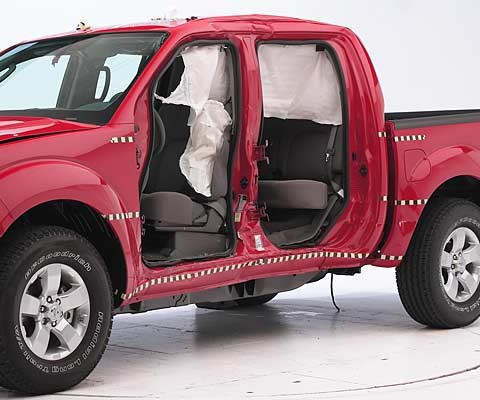
View of the vehicle after the crash with doors removed, showing the side airbags and damage to the occupant compartment.
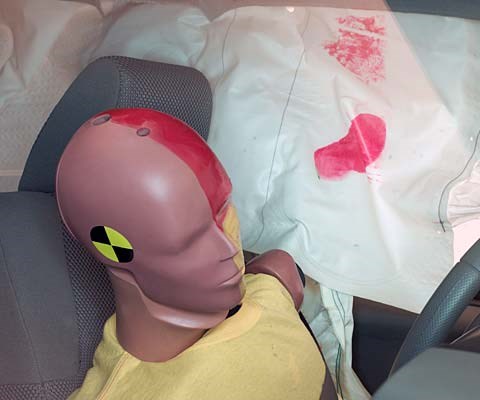
Smeared greasepaint shows where the driver dummy's head was protected from being hit by hard structures by the side curtain airbag.

Smeared greasepaint shows where the rear passenger dummy’s head was protected by the side airbag.
Measures of occupant compartment intrusion on driver side
| Test ID | CES0819 | CES0931 |
|---|---|---|
| B-pillar to longitudinal centerline of driver's seat (cm) | -15.0 | -15.5 |
| Negative numbers indicate the amount by which the crush stopped short of the seat centerline. | ||
Driver injury measures
| Evaluation criteria | Measurement |
|---|---|
| Test ID | CES0931 |
| Head HIC-15 | 107 |
| Neck | |
| Tension (kN) | 1.0 |
| Compression (kN) | 0.2 |
| Shoulder | |
| Lateral deflection (mm) | 40 |
| Lateral force (kN) | 1.1 |
| Torso | |
| Maximum deflection (mm) | 39 |
| Average deflection (mm) | 37 |
| Maximum deflection rate (m/s) | 3.72 |
| Maximum viscous criterion (m/s) | 0.61 |
| Pelvis | |
| Iliac force (kN) | 0.8 |
| Acetabulum force (kN) | 2.6 |
| Combined force (kN) | 3.4 |
| Left femur | |
| L-M force (kN) | 0.7 |
| L-M moment (Nm) | 140 |
| A-P moment (Nm) | -52 |
Passenger injury measures
| Evaluation criteria | Measurement |
|---|---|
| Test ID | CES0931 |
| Head HIC-15 | 229 |
| Neck | |
| Tension (kN) | 0.3 |
| Compression (kN) | 0.8 |
| Shoulder | |
| Lateral deflection (mm) | 34 |
| Lateral force (kN) | 1.3 |
| Torso | |
| Maximum deflection (mm) | 43 |
| Average deflection (mm) | 30 |
| Maximum deflection rate (m/s) | 4.35 |
| Maximum viscous criterion (m/s) | 0.53 |
| Pelvis | |
| Iliac force (kN) | 0.3 |
| Acetabulum force (kN) | 1.4 |
| Combined force (kN) | 1.4 |
| Left femur | |
| L-M force (kN) | 0.5 |
| L-M moment (Nm) | 87 |
| A-P moment (Nm) | -26 |
Rating applies to 2005-09 models
Tested vehicle: 2008 Nissan Frontier LE Crew Cab without optional side airbags
The Nissan Frontier was redesigned for the 2005 model year and is significantly larger and heavier than previous models. The otherwise similar Suzuki Equator was introduced in the 2009 model year, but these ratings do not apply to the Equator because it has standard side airbags. Structure ratings are based on this test and on a later test of a 2010 Frontier model with side airbags.
| Evaluation criteria | Rating |
|---|---|
| Overall evaluation | |
| Structure and safety cage | |
| Driver injury measures | |
| Head/neck | |
| Torso | |
| Pelvis/leg | |
| Driver head protection The dummy's head was hit by its left arm stub. This impact did not produce high injury measures, but the head protection is inadequate. |
|
| Rear passenger injury measures | |
| Head/neck | |
| Torso | |
| Pelvis/leg | |
| Rear passenger head protection The dummy's head was hit by the pillar behind the rear passenger door and the window glass of the rear door. These impacts did not produce high head injury measures, but the head protection is inadequate. |
|
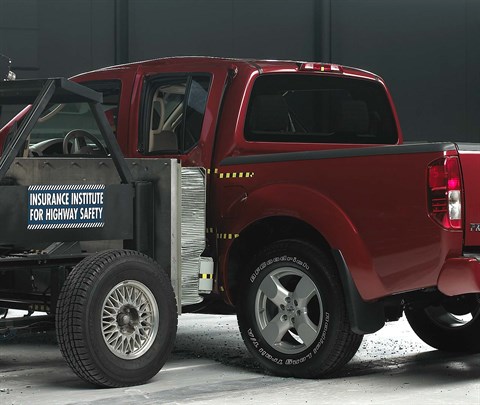
View of the vehicle and barrier just after the crash test.
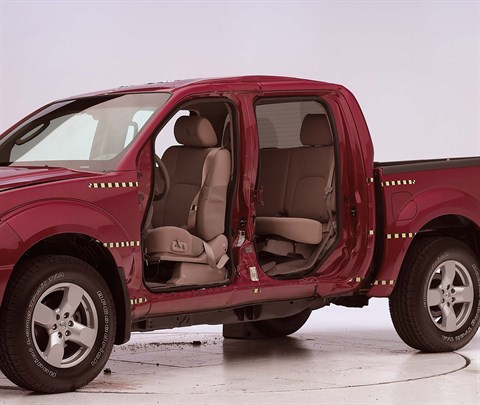
View of the vehicle after the crash with doors removed, showing the damage to the occupant compartment.
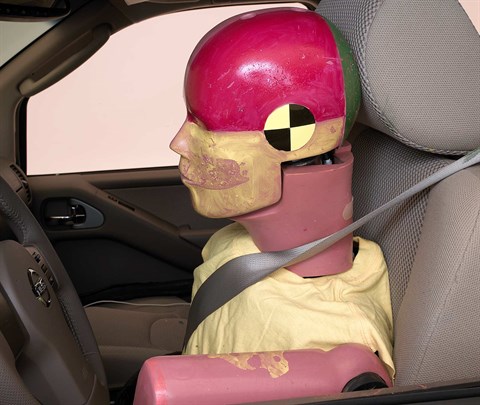
Smeared yellow greasepaint shows where the driver dummy's head was hit by the arm stub.

Smeared greasepaint shows where the rear passenger dummy's head was hit by the pillar behind the rear door and the window glass.
Measures of occupant compartment intrusion on driver side
| Test ID | CES0819 | CES0931 |
|---|---|---|
| B-pillar to longitudinal centerline of driver's seat (cm) | -15.0 | -15.5 |
| Negative numbers indicate the amount by which the crush stopped short of the seat centerline. | ||
Driver injury measures
| Evaluation criteria | Measurement |
|---|---|
| Test ID | CES0819 |
| Head HIC-15 | 62 |
| Neck | |
| Tension (kN) | 1.3 |
| Compression (kN) | 0.0 |
| Shoulder | |
| Lateral deflection (mm) | 32 |
| Lateral force (kN) | 1.5 |
| Torso | |
| Maximum deflection (mm) | 59 |
| Average deflection (mm) | 42 |
| Maximum deflection rate (m/s) | 5.56 |
| Maximum viscous criterion (m/s) | 1.62 |
| Pelvis | |
| Iliac force (kN) | 1.6 |
| Acetabulum force (kN) | 3.3 |
| Combined force (kN) | 4.9 |
| Left femur | |
| L-M force (kN) | 0.7 |
| L-M moment (Nm) | 118 |
| A-P moment (Nm) | -54 |
Passenger injury measures
| Evaluation criteria | Measurement |
|---|---|
| Test ID | CES0819 |
| Head HIC-15 | 148 |
| Neck | |
| Tension (kN) | 0.7 |
| Compression (kN) | 0.1 |
| Shoulder | |
| Lateral deflection (mm) | 38 |
| Lateral force (kN) | 1.8 |
| Torso | |
| Maximum deflection (mm) | 40 |
| Average deflection (mm) | 31 |
| Maximum deflection rate (m/s) | 3.33 |
| Maximum viscous criterion (m/s) | 0.44 |
| Pelvis | |
| Iliac force (kN) | 0.2 |
| Acetabulum force (kN) | 1.5 |
| Combined force (kN) | 1.5 |
| Left femur | |
| L-M force (kN) | 0.6 |
| L-M moment (Nm) | 139 |
| A-P moment (Nm) | -42 |
Roof strength
Rating applies to 2005-15 models
Tested vehicle: 2010 Nissan Frontier SE Crew Cab
Rating applies to both the Nissan Frontier Crew Cab (tested) and the structurally similar 2009-12 models of the Suzuki Equator Crew Cab.
| Overall evaluation | |
|---|---|
| Curb weight | 4,265 lbs |
| Peak force | 17,535 lbs |
| Strength-to-weight ratio | 4.11 |
Head restraints & seats
Seat type: Seats without adjustable lumbar AHR
| Overall evaluation | |
|---|---|
| Dynamic rating | |
| Seat/head restraint geometry |
| Seat type | Seats without adjustable lumbar AHR |
|---|---|
| Geometry | |
| Backset (mm) | 80 |
| Distance below top of head (mm) | 50 |
| Seat design parameters | |
| Pass/fail | Fail |
| Max T1 acceleration (g) | 12.8 |
| Head contact time (ms) | 81 |
| Force rating | 3 |
| Neck forces | |
| Max neck shear force (N) | 195 |
| Max neck tension (N) | 876 |
Seat type: Seats with adjustable lumbar AHR
| Overall evaluation | |
|---|---|
| Dynamic rating | |
| Seat/head restraint geometry |
| Seat type | Seats with adjustable lumbar AHR |
|---|---|
| Geometry | |
| Backset (mm) | 65 |
| Distance below top of head (mm) | 58 |
| Seat design parameters | |
| Pass/fail | Fail |
| Max T1 acceleration (g) | 11.3 |
| Head contact time (ms) | 73 |
| Force rating | 3 |
| Neck forces | |
| Max neck shear force (N) | 302 |
| Max neck tension (N) | 1,477 |
About the head restraint & seat test
Currently, IIHS tests apply only to front seats.
